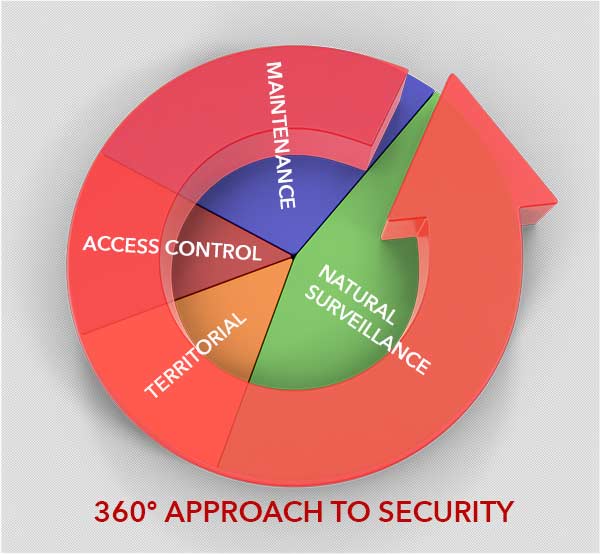Principles of CPTED Help Security Managers Protect Space.
Principles of CPTED – Crime prevention through environmental design (CPTED) is built around 9 principles that can be used by security managers to control better and protect their own and adjoining sites.
CPTED allows the introduction of an effective security policy to govern space on a site using physical and electronic means. While you normally think of space design as something that ends the minute an architect’s building plans are signed off, that’s only half the story.
Even if the design you’re stuck with creates vulnerable areas, you can make them into strengths. The idea is to push safe activities into areas that are perceived to be unsafe, to have normal users challenge abnormal users for control of space. This is one of the fundamental principles of CPTED.
Remember that the concept of CPTED is based on the psychological principle that environmental cues indicate to a normal user that a location is safe while at the same time informing an abnormal user it’s not safe to undertake abnormal behaviour.
A security manager familiar with CPTED should start to see the environment differently, recognizing safe or unsafe spaces immediately, knowing why it’s safe or unsafe, and determining what can be done to change threat levels.
There are 9 principles of CPTED, including:
- Provide clear border definitions for control of space. That means defining boundaries physically or symbolically with fences, shrubs or signs so that both normal and abnormal users recognize public-to-private space transitions. You can do the same thing inside a building using colour, light and furniture.
- Build and clearly mark transitional zones between public, semi-public, semi-private and private zones. This reduces the range of excuses for intrusion into private areas.
- Relocate gathering areas of normal users to place them in places with good surveillance and natural access control – a flight of stairs leading up to a grassy area. You can put such gathering places out of sight of areas frequented by abnormal users to draw abnormal users out into spaces controlled by normal users.
- Simultaneously, try to place safe activities in unsafe locations. This means getting the staff touch football teams to do their training on an oval alongside a street where most staff park their cars. The normal users will dominate the space, including the street, and will challenge the presence of abnormal users, who will move on.
- Bring unsafe activities into safe locations to provide the greatest measure of protection for them. Put school kids’ playing areas in front of the staff room windows with maximum surveillance. Vulnerable groups or activities should be close to lines of communication and immediate support. You can use your video surveillance system to support such activities.
- Redesignate the use of space to create natural barriers of protection. Do this by screening areas and activities that need protection from observation by abnormal users on the fringes of the site.
- Improve the scheduling of space by using open spaces that have other areas under surveillance for productive and effective activities. Build launching areas in formally unused spaces and provide well-tended gardens – both will increase your spatial control.
- Improve communication with remote areas and remote activities to accommodate company activities. Link remote workshops by phone and ensure some of your more powerful cameras can be pointed toward remote buildings in the event of an incident. Instruct security patrols to call on remote sites regularly and to keep an eye on remote activities.
You can learn more about CPTED here or read more SEN news here.
What does CPTED stand for?
Crime Prevention Through Environmental Design
What is CPTED?
Introduces the role that planning, design and urban management of our towns and cities can play in making our community safe through the implementation of CPTED principles and practices.
Examples are:
* Crimes against people and property are less likely to occur if other people are around
* The importance of people in adjoining buildings and spaces can see what is happening and encouraged to respond and help the importance to give people safe choices about where to be and how to anticipate, and respond to, problems.
“Principles Of CPTED Help Security Managers Protect Space.”










I recommend CPTED to security professionals, facility/property managers, council planners and space managers/designers.
The NSW Police used to run a free 5 day course on the subject that was fantastic including a practical component, however it may not be offered anymore – https://www.police.nsw.gov.au/safety_and_prevention/policing_in_the_community/safer_by_design
Local Government NSW offer a charged course as well (https://lgnsw.org.au/Public/Public/Events/Learning-and-Development/Courses/Crime-Prevention.aspx?LCODE=CPTED)
so there may be training options in different states to take advantage of, it is well worth it, not just for security practioners but even more by those managing facilities or designing them, so we don’t have to fix up gaps, build it secure in the first place